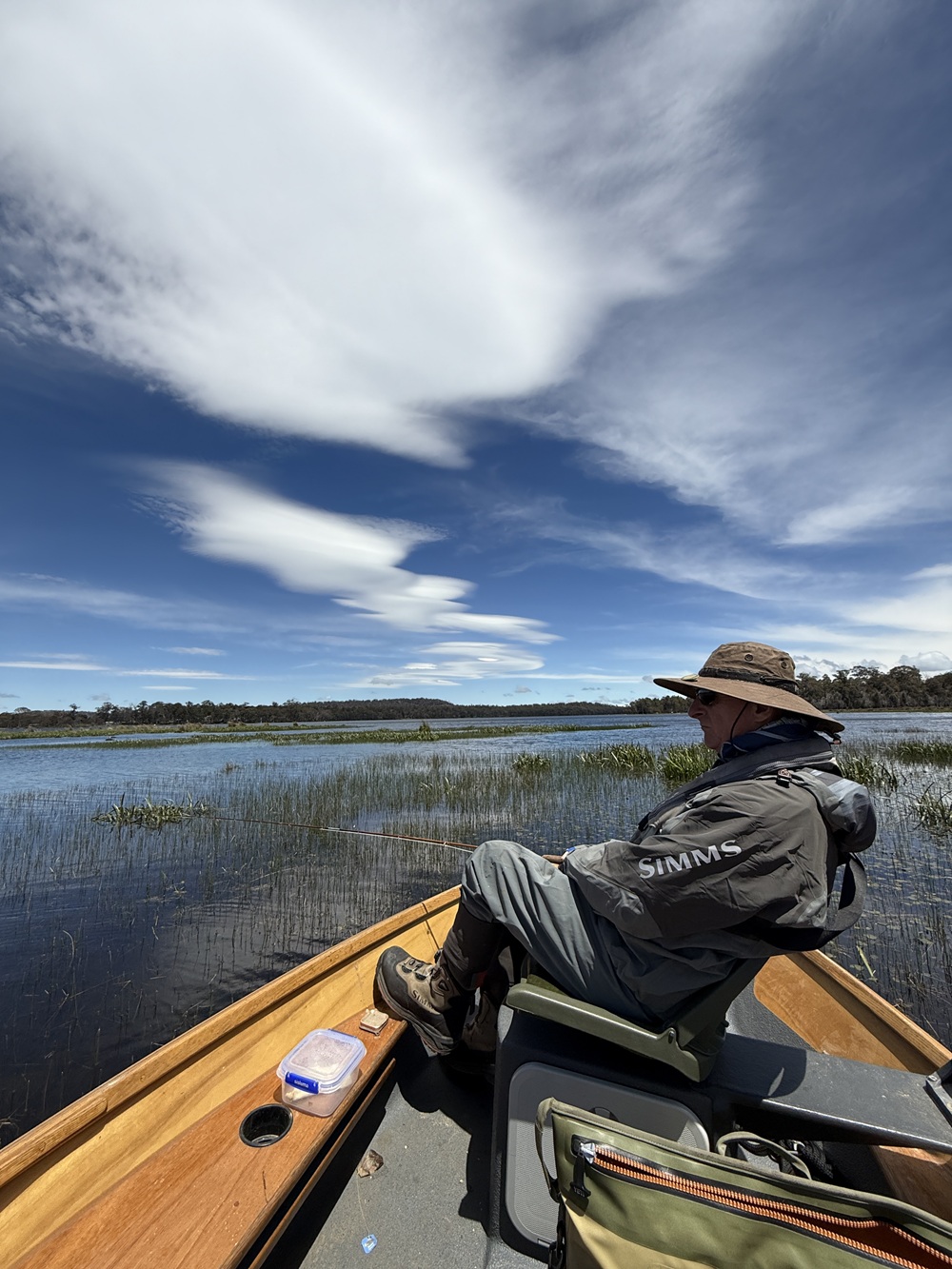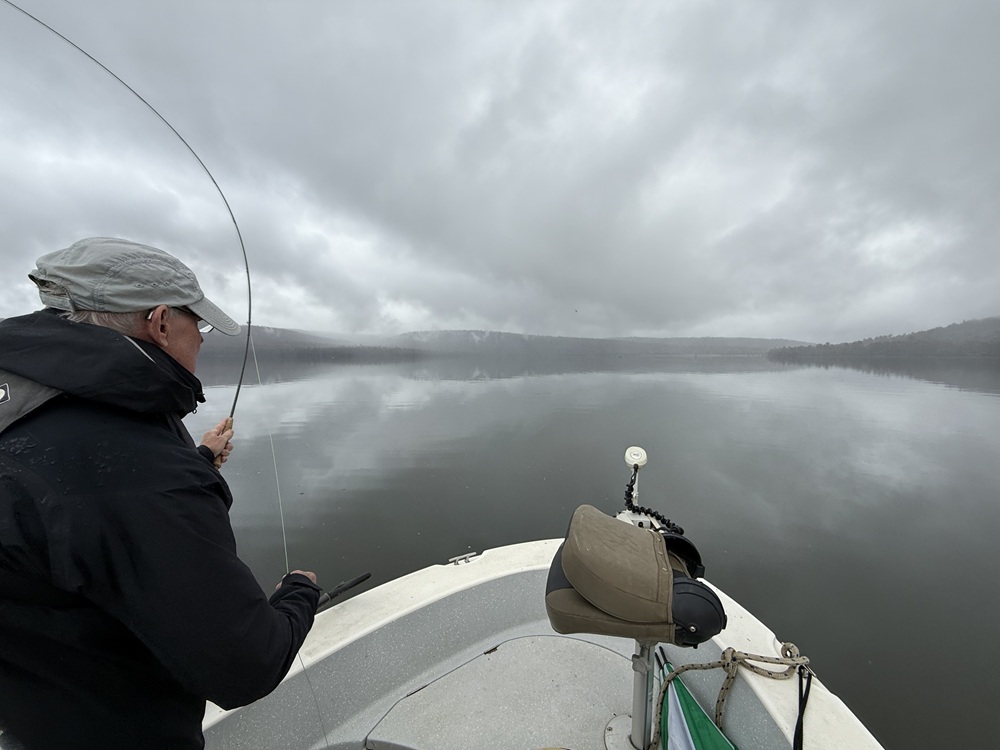
Following on from last issue, Peter discusses how to minimise spooking trout from boats.
While guiding, I often find it’s challenging to remain quiet and unobtrusive in the trout’s environment when fishing from a boat. It takes a lot of effort and skill to manoeuvre the boat so the fish remain unaware of our presence.
 Blending in using my wooden drift boat.
Blending in using my wooden drift boat.Over 30 years, I’ve owned more than a dozen different boats. Currently, I use just four: a rubber zodiac, a plastic kayak, a wooden drift boat, and a fibreglass sportfishing boat. I would never want to own an aluminium boat again. They are simply too noisy.
In shallow water, just the pressure changes from a moving boat – or perhaps more accurately, the displacement of water – alerts trout from distances beyond most casting ranges. I frequently observe this in the Western Lakes, where moving the boat in shallow, silty water causes the silt to shift, releasing millions of tiny air bubbles from the lakebed. I’m convinced fish can sense these changes.
Boat wake
Throughout my guiding career, there have been countless instances where we’ve set up on a feeding fish, only to have a passing boat spook it before we could cast. On glassy calm, windless mornings, any wake can disturb rising fish.
 Keeping low - and hoping for no wake from other boats!
Keeping low - and hoping for no wake from other boats!Just as frustratingly, many times in the early days, we’d positioned ourselves on a feeding fish in shallow water, only for a passing boat's wake to rock my boat, causing the aluminium hull to hit a rock on the bottom. The noise of an aluminium hull hitting a rock will scare fish from 60 to 70 feet away.
Poles and oars
Regarding underwater noise, let me mention my push pole. It has a steel tip, and for 90% of my work with it, which occurs on muddy or silty bottoms, the pole works well. However, on rocky ground, if trout are nearby – within a clients' casting range – and I accidentally tap a rock with the pole, the trout often vanish. The clients are unaware of why the fish disappeared, and I’m not inclined to enlighten them!
Just recently, I spooked a beautiful big brown trout which was feeding in less than a foot of water. We had observed it for 5 to 10 minutes before deciding to cast. My client knew exactly where the fish would swim and where to place his cast. We were setting a trap.
While we waited, the trout swam particularly close to the boat, which was anchored inside a reed bed. Unfortunately, my oar was jutting into its swim path just nine feet from us. As I slowly slid the oar back into the rowlocks, the oar acted like a violin bow on the boat, causing vibrations that startled the fish, which bolted for its life. I had ruined the chance to catch a trophy 5-pound wild brown trout simply by moving my oar just six inches in the rowlocks.
In shallow water, even the simple act of dropping your wet fly box onto the aluminium seat of a tinny can scare any fish within casting range. I can assure you that when those fish eventually return to their territory, they will be more wary than they were initially.
 Reward for a careful, patient approach.
Reward for a careful, patient approach.Wave slap on the hull
When I anchor my boat in the wind, I’m particularly cautious about the angle of the hull. If waves continually slap against the hull, it can be enough to spook fish, causing them to avoid our area.
Engines
Engine noises can also deter trout and other fish species. I once chatted with a permit guide from Queensland who believed it was nearly impossible to catch a permit while following them on an electric motor. He advocated using a push pole instead. I’ve certainly witnessed countless instances where the electric motor has scared our target fish.
In big waves on Great Lake, the drone of the outboard motor running steadily may not scare trout, but I often spook them when I pull the boat out of gear and the gearbox clunks into neutral – or worse, reverse. It’s the clunking noise which travels through the water and deters those fish.
Cavitation
Cavitation is an issue which arises in rough water with decent-sized waves. Occasionally, when chasing a trout on the electric motor, I’ll be far enough away that the noise of the motor doesn’t alarm it, especially given the turbulent surface. However, if the electric motor lifts out of the water as the bow of the boat rises on a swell, the noise from cavitation will scare the fish.
Drogues and Drift Fishing
Standing on the casting deck of a large aluminium boat while fishing places like Penstock Lagoon, is often a bad idea. The angler’s silhouette against the skyline is not ideal. In clear, bright conditions, trout will see you casting at them from a greater distance than you can reach. In this situation, it’s worth considering that you are not only scaring fish, but also making it more difficult for other anglers on the lake who are being more careful and considerate.
 Keep low and slow on shallow waters like Penstock.
Keep low and slow on shallow waters like Penstock.At the same time, deploying a three-foot-deep drogue in three feet of water to slow down a large boat with two tall anglers standing up, is not ideal. In addition to the drogue ripping through the weed-beds, you’re scaring fish throughout your entire drift. It’s no wonder the trout become difficult to catch when 20 or more boats are behaving this way.
When guiding on waters like Penstock Lagoon, I constantly monitor the movements of other boats. I simply do not want to fish in an area which has been disturbed by passing boats and drogues. I know the trout in those areas often become super-wary and nearly impossible to catch.
My advice is to sit low in a smaller boat, cast less often, and consider using a simple pole anchor. This way, you can fish effectively and quietly around the boat before moving on to another spot; ideally allowing the wind to drift you or, at worst, using an electric motor to get there.
I foresee a day when our fisheries managers will need to regulate angling and boat movements on our shallow highland waterways to keep the trout somewhat catchable.
Next time, we’ll look at yet more ways to spook trout – and to how to avoid doing so!











